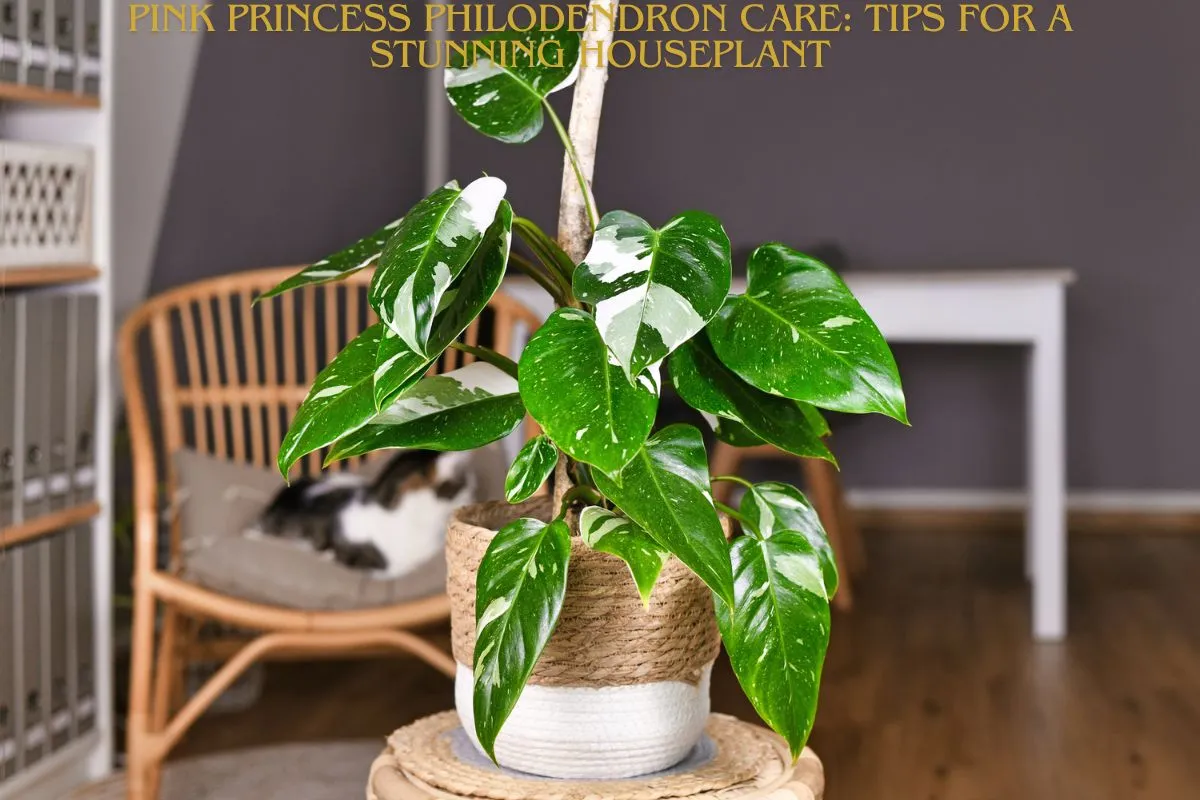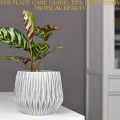If you’re looking for a houseplant that’s as glamorous as it is unique, the Pink Princess Philodendron is your perfect match. With its striking pink and green variegated leaves, this plant has taken the indoor gardening world by storm. But beyond its beauty, the Pink Princess Philodendron is a fascinating plant with specific care needs. In this article, we’ll dive into everything you need to know about this tropical gem, from its light and water requirements to tips for maintaining its stunning variegation.
Why the Pink Princess Philodendron is So Popular
The Pink Princess Philodendron is more than just a pretty face. Its vibrant pink variegation, paired with deep green leaves, makes it a showstopper in any room. But what really sets it apart is its rarity. Each plant is unique, with no two leaves having the same pattern.
I remember the first time I saw a Pink Princess Philodendron in person. It was at a local plant shop, and I was instantly drawn to its bold colors. The shop owner told me it was a bit finicky, but I was determined to give it a try. After a few months of trial and error, I finally figured out how to keep it happy—and it’s been one of my favorite plants ever since.
| Aspect | Details |
|---|---|
| Common Name | Pink Princess Philodendron |
| Scientific Name | Philodendron erubescens ‘Pink Princess’ |
| Origin | Tropical rainforests of South America |
| Light Requirements | Bright, indirect light (avoid direct sunlight to prevent leaf burn) |
| Watering Needs | Water when the top inch of soil is dry; avoid overwatering |
| Soil Type | Well-draining mix (potting soil, perlite, orchid bark) |
| Humidity | High humidity (use a humidifier or pebble tray) |
| Temperature | 65°F to 80°F (18°C to 27°C); avoid cold drafts |
| Fertilizer | Balanced liquid fertilizer every 4-6 weeks (spring and summer) |
| Growth Rate | Slow-growing |
| Toxicity | Toxic to pets and humans if ingested |
| Air-Purifying | Removes indoor toxins (improves air quality) |
| Special Feature | Pink variegation due to genetic mutation |
| Propagation | Stem cuttings (easy to propagate) |
| Common Issues | Fading variegation (low light), root rot (overwatering) |
| Pests | Spider mites, mealybugs (rare if humidity is maintained) |
| Ideal For | Collectors, tropical plant lovers, bright indoor spaces |
| Symbolism | Represents uniqueness and beauty |
| Unique Fact | Each leaf has a unique pink and green pattern |
| Best Placement | Bright, indirect light areas (e.g., near east or north-facing windows) |
| Maintenance Level | Moderate (requires attention to light, water, and humidity) |
Additional Notes for Viewers:
- Why It’s Great for Collectors: Its rare pink variegation makes it a prized plant for enthusiasts.
- Pet Safety: Keep it out of reach of pets and children, as it’s toxic if ingested.
- Variegation Tips: Bright, indirect light is key to maintaining vibrant pink colors.
- Propagation: Easily propagate through stem cuttings to grow new plants or encourage bushier growth.
What Makes the Pink Princess Philodendron Special?
1. Its Stunning Variegation
The Pink Princess Philodendron’s pink variegation is the result of a genetic mutation. This mutation reduces the amount of chlorophyll in some parts of the leaves, creating those eye-catching pink patches. According to The Spruce, “The pink variegation is a result of a genetic mutation. This makes each plant unique, and the level of pink can vary significantly.”
2. It’s a Tropical Beauty
Native to the rainforests of South America, this plant thrives in warm, humid environments. It’s part of the Araceae family, which includes other popular houseplants like Monstera and Pothos.
3. It’s a Collector’s Dream
Due to its rarity and unique appearance, the Pink Princess Philodendron is highly sought after by plant enthusiasts. It’s often considered a “holy grail” plant for collectors.
How to Care for Your Pink Princess Philodendron
Caring for a Pink Princess Philodendron can be a bit tricky, but with the right tips, you’ll have a thriving plant in no time. Here’s a simple guide to help you out:
1. Light
The Pink Princess Philodendron loves bright, indirect light. Direct sunlight can scorch its delicate leaves, while too little light can cause the pink variegation to fade. Place it near a north or east-facing window for the best results.
2. Water
Allow the top inch of soil to dry out between waterings. Overwatering is a common issue and can lead to root rot. Make sure your pot has drainage holes to prevent water from pooling at the bottom.
3. Soil
Use a well-draining soil mix. A blend of potting soil, perlite, and orchid bark works well. This ensures the roots get enough air and prevents waterlogging.
4. Humidity
This tropical plant loves humidity. If your home is dry, consider using a humidifier or placing the plant on a pebble tray filled with water.
5. Temperature
Keep your Pink Princess Philodendron in a warm spot, ideally between 65°F and 80°F (18°C to 27°C). Avoid cold drafts and sudden temperature changes.
6. Fertilizer
Feed your plant with a balanced liquid fertilizer every 4-6 weeks during the growing season (spring and summer). Reduce feeding in the fall and winter.
7. Repotting
Repot your Pink Princess Philodendron only when it outgrows its current container. These plants prefer to be slightly root-bound, so don’t rush to repot.
Fun Facts About the Pink Princess Philodendron
- It’s a Slow Grower: The Pink Princess Philodendron grows slowly, but its stunning leaves make the wait worth it.
- It’s a Natural Air Purifier: Like other Philodendrons, it helps improve indoor air quality by removing toxins.
- It’s a Conversation Starter: Its unique appearance is sure to catch the eye of anyone who visits your home.
Personal Anecdote: My Pink Princess Philodendron’s Journey
When I first brought home my Pink Princess Philodendron, I was both excited and nervous. I had heard it could be a bit finicky, and I didn’t want to mess it up. The first few weeks were smooth sailing, but then I noticed the leaves starting to lose their vibrant pink color.
After some research, I realized the plant wasn’t getting enough light. I moved it to a brighter spot, and within a few weeks, the pink variegation started to return. It was a reminder that even the most beautiful plants need the right care to thrive.
Unique Insights About the Pink Princess Philodendron
1. It’s a Great Gift Plant
The Pink Princess Philodendron’s unique appearance makes it a thoughtful gift for plant lovers. It’s like giving someone a piece of living art.
2. It’s Perfect for Small Spaces
With its compact size and slow growth, the Pink Princess Philodendron is ideal for apartments or small homes.
3. It’s a Natural Stress Reliever
Taking care of plants has been shown to reduce stress, and the Pink Princess Philodendron is no exception. Its beauty and uniqueness can bring joy and calm to any space.
Common Myths About the Pink Princess Philodendron
1. Myth: It Needs Direct Sunlight
Fact: Direct sunlight can damage its leaves. It prefers bright, indirect light.
2. Myth: It’s High-Maintenance
Fact: While it has specific care needs, it’s relatively easy to care for once you understand its requirements.
3. Myth: It’s Toxic to Pets
Fact: Like other Philodendrons, it’s toxic if ingested. Keep it out of reach of pets and children.
Conclusion
The Pink Princess Philodendron is more than just a houseplant—it’s a statement piece that brings beauty and life to any space. Its stunning variegation, tropical origins, and unique care needs make it a standout choice for plant lovers. Whether you’re a beginner or a seasoned plant parent, the Pink Princess Philodendron is sure to captivate you with its charm.
So, why not bring home a Pink Princess Philodendron and experience its magic for yourself? Trust me, it’s a decision you won’t regret.
Citations:
- The Spruce: Pink Princess Philodendron Care Guide.
- Outside In: Pink Princess Philodendron – A Complete Guide.
- General horticultural knowledge on variegated plants, Aroid plant care, and Philodendron propagation.
- Studies on variegation in plants, tissue culture, and horticultural science.










